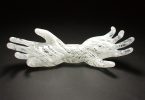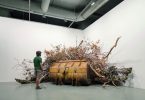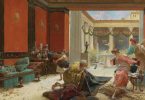The coquettish rain has inebriated Istanbul since last night. It has decked down the final flowers of the proud redbuds while illuminating the faces of the horse chestnuts. A game of the lights and thunders from the depths of the Bosphorus to the domes of Hagia Sophia have gallavanted between love and war; bringing yesterday closer to today. Under such weather as this, the only word to describe those visitors waiting in line to get into Hagia Sophia can be ‘lucky’. Furthermore, there is an exhibition of writing and space waiting for them inside.
The works of many calligraphers and illuminators from Muslim geographies can be found at this exhibition titled, ‘The Love for the Prophet’. It is possible to come across the works of many artists such as Ahmet Bursalı, Gürkan Pehlivan, Said Abuzerov, Mithat Topaç, Cevad Huran, Mustafa Cemil Efe, İbrahim Halil İslam, Muhammed Cevadzade, Ali Karavi, Hadi Kerkuki and Levent Karaduman, under the passages, dome and chirpings of the admirable Hagia Sophia. We ought to state that the dominating atmosphere of the exhibition is one related to perception and arrangement of letters. The grand venue, distant to classical arrangements and dimensions, in one aspect familiar, in another resourceful, its essence being full of love, the arrangment is candidate to caress the eyes and hearths of general audiences.
Just like in every field of art, space is poetic as well as being aesthetic within the classical Islamic arts while, the old-new and classical-modern conflict still continues. Surely, the secret of multiple approaches hidden within the poetic essence of Islamic arts and traditions has always become inherited by young artists during each era and not through the opportunities of the modern arts. In this sense, the shared work, Basmala composed by Cevad Huran and Said Abuzerov greets the classical style with its lateral lines yet, blinks to the future with its sharp and lively approach. While the mind behind this exhibition is not hesitant in reminding one of the classics, at the same time, it externalises the interpretation of space in an extraordinary manner. The figures of the Kaabah, which has been rendered solid in writing, and the caves, spider, tulips and all the other Works that sail on the floor with the determination of an imperial caique are all samples of such styles.
It is crucial to mention calligraphers such as Levent Karaduman and Gürkan Pehlivan, whose works undertake a journey between a free style compilation and visual approach together with classical art. The works of Ibrahim Halil Islam, which illustrates a transition of magic and electrons between the letter ‘vav’ and transendency of magic and visuality, ought to be mentioned as well. Likewise, the greetings of the letter ‘vav’ with heartbeats, surrounded with cufic loops presented by Gürkan Pehlivan, ought to be considered one of the greatest exhibits in which the Islamic calligraphy is externalised through a style of seeking essence and modernity. In such works as these, whether it is a question of lessening the influence of gilding or rather a problematic issue, is worth considering.
In order to observe the sense of wonder in the visitors, who have no prior knowledge about the art of calligraphy and have come from all corners of the world, it is sufficient for you to simply close your eyes and listen to the words of amazement rising in various languages. The flashes, never-ending cellphone tunes and the selfie smiles… It is evident that this exhibition is simply one part and fragment of the perception of the mutual love for the Prophet of the many calligraphers living in different parts of the world. Its potential surely lies further ahead.
The chirpings of Hagia Sophia reunites with the call of writing and infinity of time under the rain and illumination of the thunderstorms. The shrinking and expanding letters of ‘vav’, the lively thulus-style transitions that seems like it will take a step out of the frames and mingle with the curious onlookers, the adornments that clearly stand out, the recumbent roses and carnations, continuously enrichen the inventory of this space.
Those, who take a step from the exhibition to the Sultanahmet arena and head towards the works of the Ottoman heritage, will believe exactly which historical depth and description of life those writings they observed in the exhibiton came from. The rain, horse chestnuts and redbud scatterings would have already become inclusive in this space…
UNTIL JUNE 10TH
‘The Love for the Prophet’ Exhibition at Hagia Sophia, which has begun with the recitation of the Quran, includes the most prominent works of traditional Islamic art. The important examples of the Hilye-i Sharif (the description of the Prophet Mohammad), which have been written by the most prominent calligraphers, can be visited until June 10, 2015. The calligraphy exhibition that had been opened last year at the Hagia Sophia had attracted much attention, and was visited by almost 1 million people in a period of three months. We would also like to inform you that the Hagia Sophia will be closed on May 25th, between the hours of 12.00-19.00.
For more information, please visit www.ayasofyamuzesi.gov.tr.









Leave a Comment